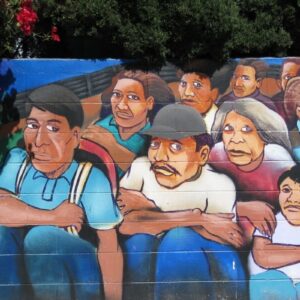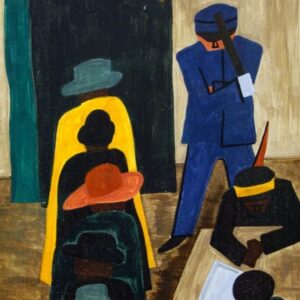
Labor Day will be different this year. Those accustomed to parades and barbecues may be disappointed. The threats that working families currently face require resistance, reimagination, and reconstruction.
May Day offered a glimpse of what is possible. Much more will be required, though, if unions, community groups, and their allies are to prevail against current authoritarian threats.
Next up: Labor Day marches on September 1 that meet the moment and center workers over billionaires.
The Movement So Far: A May Day 2025 Like No Other
May Day—International Labor Day—is typically ignored in the United States, even though it honors Chicago workers who in 1886 marched for the right to an eight-hour workday. But this year, May Day was marked by a record number of celebrations in its country of origin, as hundreds of unions and community groups organized marches.
How did this happen? In March, many groups—including the Chicago Teachers Union (CTU), Bargaining for the Common Good (BCG), the Midwest Academy, the National Education Association (NEA), and 200 community and labor organizers—met in Chicago. At that meeting, the May Day 2025 mobilization plan was launched.
May Day—International Labor Day—is typically ignored in the United States, even though it honors Chicago workers…[but 2025 was] marked by a record number of celebrations.
The response was overwhelming—more than 1,000 actions in 800-plus cities and towns across all 50 states, front-page news in 20 cities. Hundreds of thousands of workers, including 60,000 workers who walked out on strike, participated.
Comedian Jimmy Kimmel cheered that the May Day protests highlighted the “war on working people” by President Donald Trump and his administration. Mass mobilizations have continued; most recently in the No Kings rallies held on June 14 with over five million participants, possibly the largest single-day protest in US history.
From Mobilization to Lasting Movement
Mobilization is important, but building power requires more than marches. Ultimately, local coalitions will need more support to both take root and build power in their communities that translates into governing power. This requires testing and sharing models to determine what works best to advance the interests of working people. There is a growing realization by many organizers that greater coordination of existing movement infrastructure is needed to grow local leadership and build coalitions that bridge sectors and silos.
May Day 2025 was intended to kick off a three-year campaign for community and worker justice in response to the UAW’s call to align contract expiration across all bargaining units, sectors, and geographies for May 1, 2028.
But as early as the March planning meetings for those May Day protests, UAW President Shawn Fain acknowledged that “2028 may be too late.”
To sustain and strengthen the movement ecosystem to resist, reimagine, and reconstruct in a moment of great instability, May Day Strong is working to stand up 20 to 30 “strike schools” over the next eight months. These popular-education training sites will enable unions and community organizations in key geographies to activate their bases in escalating actions. They will also provide political education, workplace mapping, and member/public outreach to fuel local coalitions to reach bigger scale.
The goal, of course, is to build movement power that can preserve democratic spaces and challenge federal efforts that seek to embolden billionaire bosses and undermine an already inadequate social safety net.
In the lead-up to the second convening, our network held in-person planning meetings on July 17 and 18 and have scheduled a number of online trainings to help activists and organizers to identity and isolate the billionaire antagonists that are driving (and funding) MAGA. For example, back on June 11, BCG and ACRE led a webinar to share more about how Elon Musk of Tesla and Starlink, Antonio Gracias of Valor Equity and Peter Thiel, the former CEO of PayPal, are teaming up to dismantle Social Security and translate their White House influence into windfalls for the elite.
The objective is to bring strategically situated unions and key community organizations together for political education—and develop effective workplace and neighborhood campaign structures. This will enable a broad set of aligned forces greater capacity to advance demands, even as threats and attacks on our members intensify. To help fortify more local and statewide coalition tables and build for Labor Day marches, in-person strike schools, and beyond, ACRE and BCG are anchoring online “Skills to Win” trainings (such as this one) this August for participating organizations to ramp up their capacities.
The good news is that activists, unions, and community networks are becoming better aligned. Still, weakening the allure of MAGA will require a stronger and broader front of groups willing to take decisive action together.
A History of Labor Militancy
The possibility of mass strike action is not a romantic notion. The common lore of the general strike often overlooks the historic record of how the periodic mass refusal to work has changed the nation in profound and fundamental ways.
W.E.B. Du Bois, in Black Reconstruction in America, provides a compelling argument that the Emancipation Proclamation and the North’s victory in the Civil War would not have been possible without the “general strike of the slaves.”
Similarly, the strikes in 1886 in support of the eight-hour workday ultimately succeeded in reducing work hours and won health and safety regulations at workplaces nationwide—ultimately moving the nation away from a robber baron era dominated by a handful of industrialists and into a progressive era marked by monopoly regulation, child labor restrictions, and more.
Across the world, labor and community mobilizations have played a critical role in resisting authoritarian governments.
And the 1934 strike wave ushered in the first formal recognition of union rights at the federal level. Work stoppages in the 1930s forced the federal government to support organized labor, expand work projects, and implement Social Security.
General strikes, in short, have been a fundamental part of bending the arc of US history toward justice.
From Labor Day to a Movement That Lasts
Across the world, labor and community mobilizations have played a critical role in resisting authoritarian governments. That’s because they can mobilize masses of people in support of democracy and can help anchor “united front” coalitions. One key source of power for labor, of course, is the power to withhold their labor and strike.
Erica Chenoweth and Zoe Marks, political scientists who have studied authoritarian regimes, highlight the crucial role that both targeted and general strikes have played and could play in defending democracy. Under authoritarian regimes, the standard tactics—voting, protests, legal action—are often much less effective. Movements need to disrupt, and general strikes provide one of the clearest examples of how this can be done. Last year, for example, the Korean Confederation of Trade Unions called for a general strike and engaged in sustained rolling strikes to prevent the country’s president from instituting martial law.
Could such a threat of martial law arise in the United States? It would be foolish to pretend that this threat does not exist. Even if movement organizations act perfectly, it would not take much for President Donald Trump to wag the dog and goad the country into war. In such a scenario, the Trump administration could declare martial law to further cement control over the machinery of the state, clamp down on protest, and unilaterally reshape the social safety net to better serve a Christian nationalist agenda.
Labor and community are joining forces this Labor Day to put the billionaires on notice that people in our nation will not be quiet.
Hopefully this scenario will not come to pass, but movement actors need to be prepared. This means that movements need to develop the capacity to maximally disrupt the system. Tunisia demonstrates how local labor leaders can draw national federations, like the Tunisian General Labor Union, into a project to disrupt and halt creeping authoritarianism.
Of course, the best defense is a good offense. Rather than wait for the worst, labor and community are joining forces this Labor Day to put the billionaires on notice that people in our nation will not be quiet while Medicaid, public education, food for hungry children, and environmental protections are slashed.
In Chicago, the Chicago Federation of Labor is already planning a march that will highlight the billionaires in our midst attempting to vanquish the generational wealth of workers to feed their insatiable appetite for greed. We’ll join forces with civil rights organizations to call out Target Corporation, Tesla, T-Mobile, Vanguard Equity, and others for their racist exclusion of Black and Brown workers, anti-union stances, and efforts to eradicate and other vital social programs through the so-called Department of Government Efficiency.
Imagine when dozens or hundreds of city Central Labor Councils engage in similar actions to reshape traditional Labor Day marches into cauldrons of political education, resistance, and community building beyond the apolitical social events of the past? Consider the possibilities when carpenters, service workers, nurses, teachers, laborers, plumbers, postal workers, and ironworkers join together to forge a new path for an industrial democracy that protects our interests against the corruption and ruinous governance of a plutocracy.
In the United States, a new take on Labor Day will allow unions a critical opportunity to revive a tradition of labor militancy in the face of growing authoritarianism and make a clean break from the neoliberal model that has gutted so many worker protections and given room for growing class dealignment away from a Democratic Party that has itself often failed to promote a multiracial, working-class agenda.
Now is the time to take big risks, demand what we deserve, and fight with all that we’ve got.














